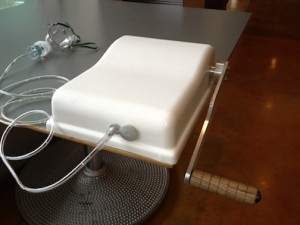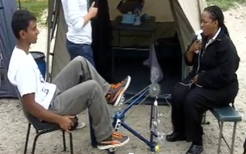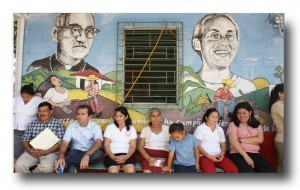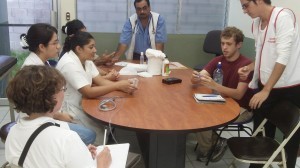The Human Powered Nebulizer – “Bringing Life and Breath”
Loyola IPS’s Dr. Therese Lysaught has been a part of the Human Powered Nebulizer (HPN) project for six years.
“I got involved in this project through an undergraduate immersion trip in 2009 when I taught at Marquette. I was invited by Chris Hallberg (who was then an undergraduate) to accompany students for a Spring break reverse-immersion trip to El Salvador. Another professor on that trip was a colleague of mine in engineering, Dr. Lars Olson. He had invented the HPN, but needed a team to help him move it from the lab to the world. That’s where Chris Hallberg and I came in. Once we had a team, the project really began to move forward,” said Therese.
She and the HPN team want to bring a life saving device to cities around the world where there is a high number of respiratory problems, but where the people are poor and often do not have immediate access to electricity.
The solution: an innovative, low-cost nebulizer that does not require electricity. The HPN will get its power from a hand crank on the side of the device. Just like any other nebulizer, the HPN converts liquid medicine into a mist that can be inhaled deep into the lungs.

Respiratory problems are a major cause of death and disability throughout the world. In fact, lower-respiratory infections (LRIs), chronic obstructive pulmonary disease (COPD), and tuberculosis (TB) account for three of the ten most prevalent causes of mortality. In addition, asthma and other respiratory problems account for a substantial and growing number of hospital visits each year. These diseases also differentially affect the poor, killing more than HIV and malaria combined.
This project could not have come at a better time for Therese, as she had recently began researching health issues like the ones above that affect people in countries around the world.
“I jumped at the chance to work on this project because a few years prior to this, I had begun to shift the focus of my work from standard issues in medical ethics (which Paul Farmer refers to as “quandaries of the rich”), to focus on the issues that plague most of the world, namely, lack of access to even the most basic care and more. So by 2009, I had been working on questions of global health and global medical ethics, and I was grateful for an opportunity to work with a team of people with a real world solution,” said Therese.
The HPN team has held focus groups, conducted clinical trials and continues to work closely with community health workers in El Salvador. Immersion into the culture is crucial to the project. For instance, the first design of the HPN was powered using leg muscles and resembled a bicycle. However, once tested, the team learned that this model was too heavy for easy transport through the villages and was not producing enough power. Some women in the community suggested using the arm muscles for power since the people use their arms for manual labor every day in that culture. This recommendation eventually led to the easy-to-carry, hand crank model it is now.

Not only does the HPN team want to make it physically compatible and efficient, but also medically. It is important that the HPN works just as effectively as an electric nebulizer. After a clinical trial in El Salvador, the results showed no statistical differences. In addition, the HPN addresses multiple respiratory conditions, unlike most global health interventions that only address one disease or condition.
Throughout the course of working on this project, there has been both challenging and rewarding moments for Therese.
“The most challenging parts of the project have been having to cultivate the virtue of patience and the cross-cultural education that such work necessarily entails. When one works on issues that involve poor people, without an intention to profit off of them, it can be a challenge to get grants and funding. Our project is low-tech, ‘appropriate’ technology that lacks the glitz and glamor that major funders like. So we have had to work much more slowly and patiently than Americans are accustomed to.
It’s also been a great challenge and privilege to work continuously in another country, to learn about that country’s cultural habits (and strengths and weaknesses) because they really teach a person about one’s own strengths and weaknesses (particularly the weaknesses). Also, repeatedly coming face-to-face with the impoverishment of a place like El Salvador—which is like much of the world—is repeatedly sobering.
This latter ‘challenge’ has also been a great reward. Probably the greatest reward, however, has been the deep gratitude of the community health workers and other front-line health care workers who have given us the great gift of working with us on our research. They are SO grateful for the HPN; they thank us over and over; they want more of them so that they can make a real difference in the lives of real people who are eking out a living in really remote areas. But every time they thank us, I know that it’s WE who should be thanking THEM, for the work they do (which is much, much harder than the work we do) and for their assistance with the project.”

In the end, the team’s goal is to produce a device that will last for 10 years and cost less than $50. “The HPN is designed to be used primarily by community health workers. The World Health Organization estimates that there are about 1.5 million community health workers in the world. We would love to put an HPN in the hands of every community health worker,” commented Therese.
As a personal goal, Therese would like “to continue to be challenged by these amazing people we get to work with in these developing countries, to continue to learn from them, to continue to work with them, and hopefully to eventually be fluent in Spanish!”
For more information on the project, device, history and more, visit hpnproject.org and like it on Facebook.
Join the conversation by following @BrianSchmisek on Twitter and @LoyolaIPS on Instagram! Also, network with the Loyola Chicago IPS community on LinkedIn.
